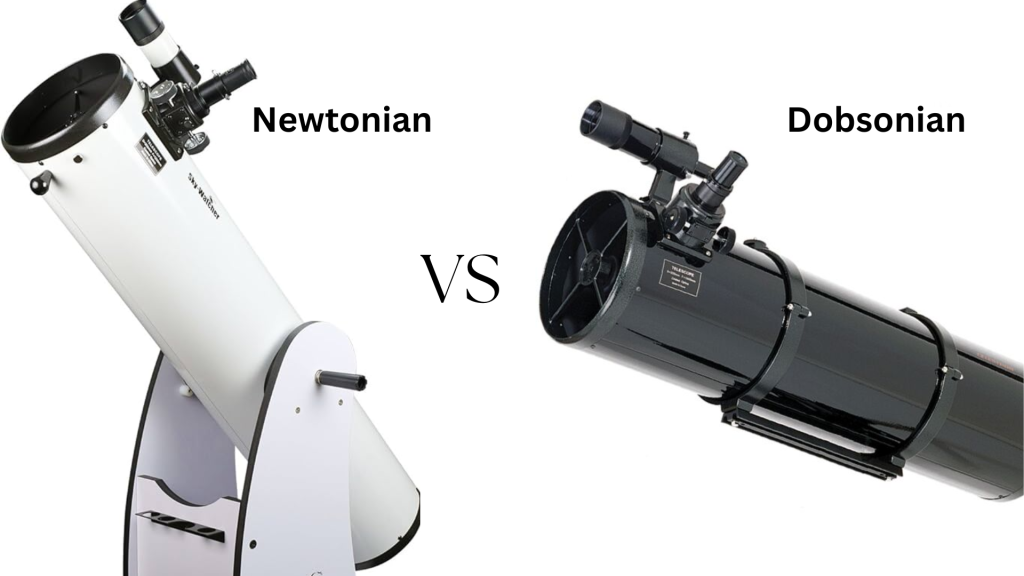Looking at stars and planets through a telescope can feel magical. But choosing the right telescope can be confusing, especially if you’re starting out.
So, the two common choices for beginners are Newtonian and Dobsonian telescopes. At first, they might look the same, but they are built differently and work in unique ways.
This blog will explain everything you need to know about Newtonian vs Dobsonian telescopes.
You’ll learn how they work, how they move, what they’re good at, and which one might be better for your stargazing experience in depth.
How Newtonian and Dobsonian Telescopes Work?
Both Newtonian and Dobsonian telescopes use mirrors to gather light, a design called a reflector. They don’t use lenses like some other telescopes.
- A Newtonian telescope has a curved mirror at the back. It reflects light to a smaller mirror near the top, which sends the image to the eyepiece. This design helps show sharp and bright views of the sky.
- Whereas, the Dobsonian telescope uses the same mirror setup as a Newtonian. What makes it different is how it sits on a base. The base is big, flat, and turns smoothly. This makes it easier to move the telescope around by hand.
Differences Between Newtonian and Dobsonian
Choosing between a Newtonian and Dobsonian telescope comes down to how they move, how easy they are to use, how portable they are, and what kind of space objects you want to observe.
Below is a clear look at how they differ in each area.
1. Mount Style and Movement
One of the biggest differences between Newtonian vs Dobsonian is how they move.
Newtonian telescopes usually have an equatorial mount, which moves in accordance with how the Earth rotates.
It helps you follow stars and planets for a long time without needing to adjust too much.
Dobsonian telescopes use an alt-azimuth mount. This type moves up and down (altitude) and left to right (azimuth). It’s simple to use, but you need to move it more often to keep objects in view.
2. Setup and Use
Setting up a telescope can take time, depending on the type of mount.
- Newtonian telescopes need careful alignment with the sky’s axis. This setup can take longer, but it’s helpful for tracking objects smoothly.
- Dobsonian telescopes are much easier to set up. You just place them on the ground, and they’re ready to use. There’s no need for special tools or alignment.
3. Size and Portability
When thinking about Newtonian vs Dobsonian, it’s also good to consider how easy they are to carry.
Newtonian telescopes often have metal tripods and parts that can be heavy. They take up more space and can be harder to move.
Dobsonian telescopes have fewer parts and sit low to the ground. Some even come with handles or wheels. This makes them easier to carry and store.
4. What Each Telescope is Best At
Different telescopes are better for different kinds of viewing.
Newtonian telescopes are great for looking at the moon and planets. They offer higher magnification, which helps show more details.
They also work well for astrophotography, though this takes extra tools and practice.
Dobsonian telescopes are best for deep-sky objects, like galaxies and star clusters.
Their large mirrors collect more light, making it easier to see faint things far away. They’re not ideal for taking pictures, but they give amazing views with just your eyes.
How to Care for Both Telescopes?
Keeping your telescope clean and working well helps it last longer.
Newtonian Telescope Maintenance
- Adjust the mirrors (collimation) regularly to keep images sharp.
- Watch out for dust inside the tube.
- Clean mirrors gently using proper tools.
- Handle with care after moving to keep the alignment correct.
Dobsonian Telescope Maintenance
- Gently clean the mirrors from time to time.
- Check the base to ensure it moves smoothly.
- Keep dust out of the tube when not in use.
- Minimal maintenance is needed due to the simple mount design.
- Price Range of Both Telescopes
Price and Value Comparison
| Telescope Type | Price Range | Value |
|---|---|---|
| Newtonian | $100 – $1,500+ | Good for serious beginners and future upgrades. |
| Dobsonian | $150 – $2,000+ | Great for big mirrors and deep-sky viewing. |
Dobsonians usually offer more power for the price, especially when you’re focused on deep-sky objects. Newtonians offer more options if you want to get into photography or tracking stars.
Final Thoughts
So, which one should you pick—Newtonian or Dobsonian? The answer depends on what you want to see and how you want to use your telescope.
If you want more control and maybe plan to take pictures later, a Newtonian might be right for you. It gives you flexibility and clear close-up views of planets.
But if you want something that’s easy to set up and gives big, bright views of faraway galaxies, go with a Dobsonian. It’s simple, powerful, and beginner-friendly.
In the end, both telescopes can give you amazing stargazing experiences.




















